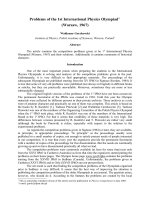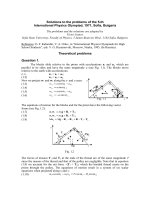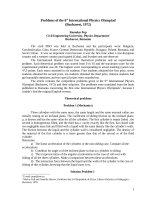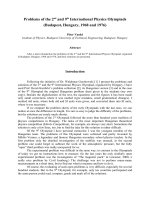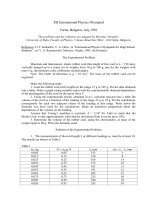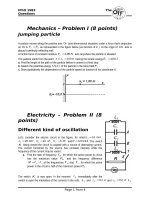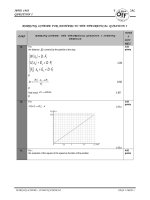- Trang chủ >>
- Đại cương >>
- Kinh tế vi mô
De thi vat li quoc te IPHO nam 20038
Bạn đang xem bản rút gọn của tài liệu. Xem và tải ngay bản đầy đủ của tài liệu tại đây (133.32 KB, 6 trang )
<span class='text_page_counter'>(1)</span><div class='page_container' data-page=1>
<i>Solution- Theoretical Question 3</i>
<i>Part A</i>
<i><b>Neutrino Mass and Neutron Decay</b></i>
(a) Let (<i>c</i>2<i>Ee, cq</i>⃗<i>e</i>) , (<i>c</i>2<i>Ep,c</i>⃗<i>qp</i>) , and (<i>c</i>2<i>Ev,c</i>⃗<i>qv</i>) be the energy-momentum
4-vectors of the electron, the proton, and the anti-neutrino, respectively, in the rest
frame of the neutron. Notice that <i>E<sub>e</sub>, E<sub>p</sub>, E<sub>ν</sub>,</i>⃗<i>q<sub>e</sub>,</i>⃗<i>q<sub>p</sub>,</i>⃗<i>q<sub>ν</sub></i> <sub> are all in units of mass. </sub>
The proton and the anti-neutrino may be considered as forming a system of total
rest mass <i>M<sub>c</sub></i> , total energy <i>c</i>2<i>Ec</i> , and total momentum <i>c</i>⃗<i>qc</i> . Thus, we
have
<i>E<sub>c</sub></i>=<i>E<sub>p</sub></i>+<i>E<sub>v</sub></i> <sub>, </sub> ⃗<i>q<sub>c</sub></i>=⃗<i>q<sub>p</sub></i>+ ⃗<i>q<sub>v</sub></i> <sub>, </sub> <i><sub>M</sub><sub>c</sub></i>2=<i>E<sub>c</sub></i>2<i>−q<sub>c</sub></i>2 <sub> (A1)</sub>
Note that the magnitude of the vector ⃗<i>q<sub>c</sub></i> <sub> is denoted as </sub><i><sub>qc</sub></i><sub>. The same convention </sub>
also applies to all other vectors.
Since energy and momentum are conserved in the neutron decay, we have
<i>E<sub>c</sub></i>+<i>E<sub>e</sub></i>=<i>m<sub>n</sub></i> <sub> (A2)</sub>
⃗
<i>q<sub>c</sub></i>=<i>−q</i>⃗<i><sub>e</sub></i> <sub> (A3)</sub>
When squared, the last equation leads to the following equality
<i>qc</i>2=<i>q</i>2<i>e</i>=<i>Ee</i>2<i>− me</i>2 (A4)
From Eq. (A4) and the third equality of Eq. (A1), we obtain
<i>Ec</i>2<i>− Mc</i>2=<i>Ee</i>2<i>−me</i>2 (A5)
With its second and third terms moved to the other side of the equality, Eq. (A5)
may be divided by Eq. (A2) to give
<i>E<sub>c</sub>− E<sub>e</sub></i>= 1
<i>m<sub>n</sub></i>(<i>Mc</i>
2
<i>−m<sub>e</sub></i>2) <sub> (A6)</sub>
As a system of coupled linear equations, Eqs. (A2) and (A6) may be solved to give
<i>E<sub>c</sub></i>= 1
2<i>m<sub>n</sub></i>(<i>mn</i>
2
<i>−m<sub>e</sub></i>2+<i>M<sub>c</sub></i>2) <sub> (A7)</sub>
<i>E<sub>e</sub></i>= 1
2<i>m<sub>n</sub></i>(<i>mn</i>
2
+<i>m<sub>e</sub></i>2<i>− M</i>2<i><sub>c</sub></i>) <sub> (A8)</sub>
Using Eq. (A8), the last equality in Eq. (A4) may be rewritten as
2<i>mnm</i>¿2
¿
<i>m<sub>n</sub></i>2
+<i>m<sub>e</sub></i>2<i>− M<sub>c</sub></i>2¿2<i>−</i>¿
¿
¿
<i>q<sub>e</sub></i>= 1
2<i>mn</i>√¿
(A9)
Eq. (A8) shows that a maximum of <i>E<sub>e</sub></i> corresponds to a minimum of
</div>
<span class='text_page_counter'>(2)</span><div class='page_container' data-page=2>
minimum
<i>M</i>=<i>m<sub>p</sub></i>+<i>m<sub>v</sub></i> (A10)
when the proton and the anti-neutrino are both at rest in the center of mass frame.
Hence, from Eqs. (A8) and (A10), the maximum energy of the electron <i>E </i>= <i>c</i>2<i><sub>Ee</sub></i><sub> is</sub>
<i>mp</i>+<i>mv</i>¿
2
<i>mn</i>
2
+<i>me</i>
2
<i>−</i>¿<i>≈</i>1 .292569 MeV<i>≈1 . 29 MeV</i>
<i>E</i><sub>max</sub>= <i>c</i>
2
2<i>mn</i>
¿
(A11)*1
When Eq. (A10) holds, the proton and the anti-neutrino move with the same
velocity <i>vm</i> of the center of mass and we have
<i>v<sub>m</sub></i>
<i>c</i> =(
<i>q<sub>v</sub></i>
<i>Ev</i>
)¿<i><sub>E</sub></i><sub>=</sub><i><sub>E</sub></i>
max=(
<i>q<sub>p</sub></i>
<i>Ep</i>
)¿<i><sub>E</sub></i><sub>=</sub><i><sub>E</sub></i>
max=(
<i>q<sub>c</sub></i>
<i>Ec</i>
)¿<i><sub>E</sub></i><sub>=</sub><i><sub>E</sub></i>
max=(
<i>q<sub>e</sub></i>
<i>Ec</i>
)¿<i><sub>M</sub></i>
<i>c</i>=<i>mp</i>+<i>mv</i> (A12)
where the last equality follows from Eq. (A3). By Eqs. (A7) and (A9), the last
expression in Eq. (A12) may be used to obtain the speed of the anti-neutrino when
<i>E</i> = <i>E</i>max. Thus, with <i>M</i> = <i>mp</i>+<i>mv</i>, we have
<i>v<sub>m</sub></i>
<i>c</i> =
√
(<i>m<sub>n</sub></i>+<i>m<sub>e</sub></i>+<i>M</i>)(<i>m<sub>n</sub></i>+<i>m<sub>e</sub>− M</i>)(<i>m<sub>n</sub>− m<sub>e</sub></i>+<i>M</i>)(<i>m<sub>n</sub>− m<sub>e</sub>− M</i>)<i>mn</i>
2
<i>− me</i>
2
+<i>M</i>2
0 . 00126538<i>≈</i>0. 00127
(A13)*
<b>---[Alternative Solution]</b>
Assume that, in the rest frame of the neutron, the electron comes out with
momentum <i>c</i>⃗<i>q<sub>e</sub></i> <sub>and energy </sub><i><sub>c</sub></i>2<i><sub>Ee</sub></i><sub>, the proton with </sub> <i><sub>c</sub></i><sub>⃗</sub><i><sub>q</sub></i>
<i>p</i> and <i>c</i>2<i>Ep</i> , and the
anti-neutrino with <i>c</i>⃗<i>q<sub>v</sub></i> and <i>c</i>2<i>Ev</i> . With the magnitude of vector ⃗<i>qα</i> denoted
by the symbol <i>q</i>, we have
<i>Ep</i>
2
=<i>m</i>2<i><sub>p</sub></i>+<i>q</i>2<i><sub>p</sub></i> , <i>E<sub>v</sub></i>2=<i>m<sub>v</sub></i>2+<i>q</i>2<i><sub>v</sub></i> , <i>E<sub>e</sub></i>2=<i>m<sub>e</sub></i>2+<i>q<sub>e</sub></i>2 (1A)
Conservation of energy and momentum in the neutron decay leads to
<i>E<sub>p</sub></i>+<i>E<sub>v</sub></i>=<i>m<sub>n</sub>− E<sub>e</sub></i> <sub> (2A)</sub>
⃗
<i>q<sub>p</sub></i>+ ⃗<i>q<sub>v</sub></i>=<i>−q</i>⃗<i><sub>e</sub></i> <sub> (3A)</sub>
When squared, the last two equations lead to
<i>mn− Ee</i>¿
2
<i>Ep</i>2+<i>E</i>2<i>v</i>+2<i>EpEv</i>=¿ (4A)
<i>qp</i>2+<i>qv</i>2+2⃗<i>qp⋅q</i>⃗<i>v</i>=<i>qe</i>2=<i>Ee</i>2<i>− me</i>2 (5A)
Subtracting Eq. (5A) from Eq. (4A) and making use of Eq. (1A) then gives
<i>m</i>2<i>p</i>+<i>mv</i>2+2(<i>EpEv−q</i>⃗<i>p⋅</i>⃗<i>qv</i>)=<i>mn</i>2+<i>me</i>2<i>−</i>2<i>mnEe</i> (6A)
or, equivalently,
2<i>mnEe</i>=<i>m</i>2<i>n</i>+<i>me</i>2<i>− m</i>2<i>p− m</i>2<i>v−</i>2(<i>EpEv−q</i>⃗<i>p⋅</i>⃗<i>qv</i>) (7A)
If is the angle between ⃗<i>q<sub>p</sub></i> and ⃗<i>q<sub>v</sub></i> , we have ⃗<i>q<sub>p</sub>⋅q</i>⃗<i><sub>v</sub></i>=<i>q<sub>p</sub>q<sub>v</sub></i>cosθ ≤ q<i><sub>p</sub>q<sub>v</sub></i> so
</div>
<span class='text_page_counter'>(3)</span><div class='page_container' data-page=3>
that Eq. (7A) leads to the relation
2<i>mnEe≤mn</i>
2
+<i>me</i>
2
<i>− mp</i>
2
<i>− mv</i>
2
<i>−</i>2(<i>EpEv−qpqv</i>) (8A)
Note that the equality in Eq. (8A) holds only if = 0, i.e., the energy of the electron
<i>c</i>2<i><sub>Ee</sub></i><sub> takes on its maximum value only when the anti-neutrino and the proton </sub><i><sub>move in </sub></i>
<i>the same direction</i>.
Let the speeds of the proton and the anti-neutrino in the rest frame of the neutron
be <i>cβ<sub>p</sub></i> and <i>cβ<sub>v</sub></i> , respectively. We then have <i>q<sub>p</sub></i>=<i>β<sub>p</sub>E<sub>p</sub></i> <sub> and </sub> <i>q<sub>v</sub></i>=<i>β<sub>v</sub>E<sub>v</sub></i> <sub>. As</sub>
shown in Fig. A1, we introduce the angle <i>v</i> ( 0<i>≤ φv</i><<i>π</i>/2 ) for the antineutrino by
<i>q<sub>v</sub></i>=<i>m<sub>v</sub></i>tan<i>φ<sub>v</sub></i> <sub>, </sub> <i><sub>E</sub><sub>v</sub></i>=
√
<i>m</i>2<i><sub>v</sub></i>+<i>q<sub>v</sub></i>2=<i>m<sub>v</sub></i>sec<i>φ<sub>v</sub></i> <sub>, </sub> <i>βv</i>=<i>qv</i>/<i>Ev</i>=sin<i>φv</i> (9A)Similarly, for the proton, we write, with 0<i>≤ φp</i><<i>π</i>/2 ,
<i>q<sub>p</sub></i>=<i>m<sub>p</sub></i>tan<i>φ<sub>p</sub></i> <sub>, </sub> <i><sub>E</sub><sub>p</sub></i><sub>=</sub>
<sub>√</sub>
<i><sub>m</sub></i>2<i><sub>p</sub></i><sub>+</sub><i><sub>q</sub></i>2<i><sub>p</sub></i><sub>=</sub><i><sub>m</sub><sub>p</sub></i><sub>sec</sub><i><sub>φ</sub><sub>p</sub></i> <sub>, </sub> <i>β<sub>p</sub></i>=<i>q<sub>p</sub></i>/<i>E<sub>p</sub></i>=sin<i>φ<sub>p</sub></i> <sub> (10A)</sub>Eq. (8A) may then be expressed as
2<i>m<sub>n</sub>E<sub>e</sub>≤m<sub>n</sub></i>2
+<i>m<sub>e</sub></i>2<i>− m</i>2<i><sub>p</sub>− m</i>2<i><sub>v</sub>−</i>2<i>m<sub>p</sub>m<sub>v</sub></i>(1<i>−</i>sin<i>φp</i>sin<i>φv</i>
cos<i>φp</i>cos<i>φv</i>
) (11A)
The factor in parentheses at the end of the last equation may be expressed as
1<i>−</i>sin<i>φp</i>sin<i>φv</i>
cos<i>φ<sub>p</sub></i>cos<i>φ<sub>v</sub></i> =
1−sin<i>φp</i>sin<i>φv−</i>cos<i>φp</i>cos<i>φv</i>
cos<i>φ<sub>p</sub></i>cos<i>φ<sub>v</sub></i> +1=
1<i>−</i>cos(<i>φp− φv</i>)
cos<i>φ<sub>p</sub></i>cos<i>φ<sub>v</sub></i> +1<i>≥</i>1 (12A)
and clearly assumes its minimum possible value of 1 when <i>p</i> = <i>v</i>, i.e., when the
anti-neutrino and the proton <i>move with the same velocity</i> so that <i>p</i> = <i>v</i>. Thus, it
follows from Eq. (11A) that the maximum value of <i>Ee</i> is
<i>E<sub>e</sub></i>¿<sub>max</sub>= 1
2<i>m<sub>n</sub></i>(<i>mn</i>
2
+<i>m<sub>e</sub></i>2<i>− m</i>2<i><sub>p</sub>− m</i>2<i><sub>v</sub>−</i>2m<i><sub>p</sub>m<sub>v</sub></i>)
¿
<i>m</i>2<i><sub>n</sub></i>+<i>m<sub>e</sub></i>2<i>−</i>¿
¿
¿
(13A)*
and the maximum energy of the electron <i>E </i>= <i>c</i>2<i><sub>Ee</sub></i><sub> is</sub>
<i>E<sub>e</sub></i>¿<sub>max</sub><i>≈</i>1 . 292569 MeV<i>≈</i>1. 29 MeV
<i>E</i><sub>max</sub>=<i>c</i>2¿ (14A)*
When the anti-neutrino and the proton move with the same velocity, we have,
from Eqs. (9A), (10A), (2A) ,(3A), and (1A), the result
<i>β<sub>v</sub></i>=<i>β<sub>p</sub></i>=<i>qp</i>
<i>Ep</i>
=<i>qv</i>
<i>Ev</i>=
<i>q<sub>p</sub></i>+<i>q<sub>v</sub></i>
<i>Ep</i>+<i>Ev</i>=
<i>q<sub>e</sub></i>
<i>mn− Ee</i>=
√
<i>E</i>2<i><sub>e</sub>−m<sub>e</sub></i>2<i>mn− Ee</i> (15A)
Substituting the result of Eq. (13A) into the last equation, the speed <i>vm</i> of the
<i>anti-Ev</i>
<i>mv</i>
<i>qv</i>
<i>v</i>
</div>
<span class='text_page_counter'>(4)</span><div class='page_container' data-page=4>
neutrino when the electron attains its maximum value <i>E</i>max is, with <i>M</i> = <i>mp</i>+<i>mv</i>, given
by
<i>Ee</i>¿max2 <i>− me</i>2
¿
<i>E<sub>e</sub></i>¿<sub>max</sub>
¿
<i>m<sub>n</sub></i>2
+<i>m<sub>e</sub></i>2<i>− M</i>2¿2<i>−</i>4<i>m<sub>n</sub></i>2<i>m<sub>e</sub></i>2
¿
¿
2<i>m<sub>n</sub></i>2<i>−</i>(<i>m<sub>n</sub></i>2+<i>m<sub>e</sub></i>2<i>− M</i>2)
¿
¿
√¿
<i>m<sub>n</sub>−</i>¿
¿
√¿
<i>βv</i>¿max<i>E<sub>e</sub></i>=¿
¿
<i>v<sub>m</sub></i>
<i>c</i> =¿
(16A)*
<i>---Part B</i>
<i><b>Light Levitation</b></i>
(b) Refer to Fig. B1. Refraction of light at the spherical surface obeys Snell’s law and
leads to
<i>n</i>sin<i>θ<sub>i</sub></i>=sin<i>θ<sub>t</sub></i> <sub> (B1)</sub>
Neglecting terms of the order (/<i>R</i>)3or higher in sine functions, Eq. (B1) becomes
<i>nθ<sub>i</sub>≈ θ<sub>t</sub></i> <sub> (B2)</sub>
For the triangle <i>FAC</i> in Fig. B1, we have
<i>β</i>=<i>θt− θi≈ nθi− θi</i>=(<i>n −</i>1)<i>θi</i> (B3)
Let <i>f</i><sub>0</sub> be the frequency of the incident light.
If <i>n<sub>p</sub></i> is the number of photons incident on the
plane surface per unit area per unit time, then the
total number of photons incident on the plane
surface per unit time is <i>np</i>πδ2 . The total power
<i>P</i> of photons incident on the plane surface is
(<i>n<sub>p</sub></i>πδ2)(hf<sub>0</sub>) ,with <i>h</i> being Planck’s constant.
Hence,
<i>n<sub>p</sub></i>= <i>P</i>
πδ2<sub>hf</sub>
0
(B4)
The number of photons incident on an annular disk
of inner radius <i>r</i> and outer radius <i>r</i> +<i>dr</i> on the plane
surface per unit time is <i>np</i>(2<i>π</i>rdr) , where
<i>r</i>=<i>R</i>tan<i>θ<sub>i</sub>≈ Rθ<sub>i</sub></i> <sub>. Therefore,</sub>
<i>F</i>
<i>A</i>
<i>t</i>
<i>i</i>
<i>i</i>
<i>C</i>
Fig. B1
<i>z</i>
</div>
<span class='text_page_counter'>(5)</span><div class='page_container' data-page=5>
<i>np</i>(2<i>π</i>rdr)<i>≈ np</i>(2<i>πR</i>2)<i>θidθi</i> (B5)
The <i>z</i>-component of the momentum carried away per unit time by these photons
when refracted at the spherical surface is
dF<i><sub>z</sub></i>=<i>n<sub>p</sub></i>hf<i>o</i>
<i>c</i> (2<i>π</i>rdr)cos<i>β ≈ np</i>
hf<sub>0</sub>
<i>c</i> (2<i>πR</i>
2
)(1<i>−β</i>
2
2 )<i>θidθi</i>
<i>n −</i>1¿2
¿
<i>θ<sub>i</sub>−</i>¿<i>dθ<sub>i</sub></i>
<i>np</i>
hf<sub>0</sub>
<i>c</i> (2<i>πR</i>
2
)¿
(B6)
so that the <i>z</i>-component of the total momentum carried away per unit time is
<i>n −1</i>¿2
<i>θ<sub>i</sub>−</i>¿<i>dθ<sub>i</sub></i>
¿
<i>n −1</i>¿2
1−¿
¿
¿
<i>F<sub>z</sub></i>=2<i>πR n<sub>p</sub></i>(hf0
<i>c</i> )
∫
¿ (B7)
where tan<i>θ</i>im=
<i>δ</i>
<i>R≈θ</i>im . Therefore, by the result of Eq. (B5), we have
<i>n−</i>1¿2<i>δ</i>2
<i>n−</i>1¿2<i>δ</i>2
¿
1−¿
¿=<i>P</i>
<i>c</i> ¿
1−¿
<i>F<sub>z</sub></i>= <i>πR</i>
2
<i>P</i>
πδ2hf<sub>0</sub>(
hf0
<i>c</i> )
<i>δ</i>2
<i>R</i>2¿
(B8)
The force of optical levitation is equal to the sum of the <i>z</i>-components of the forces
exerted by the incident and refracted lights on the glass hemisphere and is given by
<i>n −1</i>¿2<i>δ</i>2
<i>n −1</i>¿2<i>δ</i>2
¿
¿
¿=¿
1−¿
<i>P</i>
<i>c</i>+(<i>− Fz</i>)=
<i>P</i>
<i>c</i> <i>−</i>
<i>P</i>
<i>c</i> ¿
(B9)
</div>
<span class='text_page_counter'>(6)</span><div class='page_container' data-page=6>
<i>n−</i>1¿2<i>δ</i>2
¿
<i>P</i>=4 mgcR
2
¿
</div>
<!--links-->

